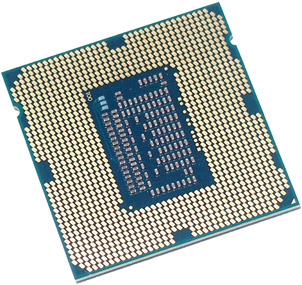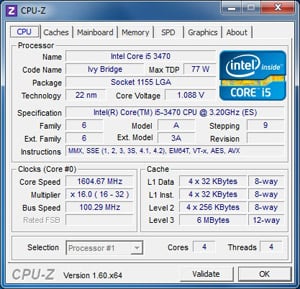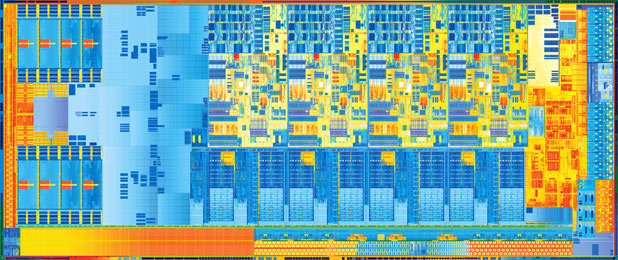Intel Core i5-3470 Ivy Bridge Quad-Core CPU Review
Last month, Intel unleashed its highly anticipated Ivy Bridge microarchitecture. We had been hearing about Ivy Bridge for what seemed like an eternity leading up to the launch, and although not based a totally new design, Ivy Bridge would offer a number of enticing enhancements, like a faster Quick Sync engine, significantly improved integrated graphics, and lower power, thanks to architectural improvements and an advanced 22nm manufacturing process.
We initially took a look at Intel’s flagship Ivy Bridge-based processor, the Core i7-3770K. The Core i7-3770K is an unlocked quad-core processor with 8MB of L3 cache; integrated Intel HD 4000 series graphics; and Hyper-Threading, PCI Express 3.0 and Turbo Boost 2.0 support. The processor we’ll be showing you today, although also based on Ivy Bridge, is somewhat different. The new Core i5-3470 is based on the same quad-core die as the Core i7-3770, but it’s outfitted with less cache, a lower-end graphics core, and lacks support for Hyper-Threading, among other things.
A full feature comparison of Intel’s Ivy Bridge-based Core i7, i5, and i3 processors is listed in the table below. Check it out for a quick break-down and we’ll follow up with the skinny on the new Core i5-3470 specifically on the pages ahead...


Intel Core i5-3470 Ivy Bridge-based Quad-Core Desktop Processor, Top and Bottom
|
|
Core i7 |
Core i5 |
Core i3 |
|
| Number of Cores / Threads | 4 / 8 | 4 / 4 | 2 / 4 |
| Intel Turbo Boost Technology 2.0 | Yes | Yes | No |
| Intel Hyper-Threading Technology | Yes | No | Yes |
| Intel Smart Cache | 8MB L3 | 6MB L3 | 3MB L3 |
| AES New Instructions (AES-NI) | Yes | Yes | No |
| Intel HD Graphics with DirectX 11 | 4000 | 2500 / 4000 | 2500 / 4000 |
| Intel Virtualization Technology (VT-x) | Yes | Yes | Yes |
| Performance Tuning Enabled | Yes | Yes | No |
| Recommended Chipset | Z77 | H77 | H61 |
Feature |
Benefit |
| Intel Turbo Boost Technology 2.0 | Dynamically increases the processor's frequency as needed by taking advantage of thermal and power headroom to give you a burst of speed when you need it. |
| Intel Hyper-Threading Technology | Delivers two processing threads per physical core. Highly threaded applications can get more work done in parallel, completing tasks sooner. |
| Integrated Memory Controller | An integrated memory controller offers stunning memory read/write performance through efficient prefetching algorithms, lower latency, and higher memory bandwidth. |
| Built-In Visuals | Intel Quick Sync Video—Delivers fast conversion of video for portable media players, online sharing, and video editing and authoring. Intel Clear Video HD—Visual quality and color fidelity enhancements for HD playback for a sharper, smoother, and richer picture. Intel InTru 3D—Stereoscopic 3-D Blu-ray playback in full 1080p resolution over HDMI 1.4 and premium audio. Intel HD Graphics—Enhanced 3-D performance for immersive mainstream and casual gaming. Intel Advanced Vector Extensions—A set of new instructions to improve software performance for floating point-intensive applications such as audio processing, audio codecs, and image and video editing applications. |
| Intel Smart Cache | The shared cache is dynamically allocated to each processor core, based on workload. This significantly reduces latency, improving performance. |
| AES New Instructions (AES-NI) | New AES instructions add hardware acceleration to AES algorithms and speed up the execution of AES applications. |
| Intel Virtualization Technology | Allows one hardware platform to function as multiple "virtual" platforms. Offers improved manageability by limiting downtime and maintaining productivity by isolating computing activities into separate partitions. |
| Thermal Solution for Boxed CPUs | Includes a four-pin connector for fan speed control to help minimize the acoustic noise levels generated from running the fan at higher speeds for thermal performance. |
Because the Core i5-3470 is built around the same die as the Core i7-3770K (and all other quad-core Ivy Bridge-based processors), it has many of the same features and capabilities. We won’t, however, be re-hashing them all again here, since we covered them in the initial launch. if you’d like the fully scoop on Ivy Bridge and all it brings to the table, we’d suggest checking out our coverage of the Core i7-3770K and its mobile cousin, the Core i7-3720QM—we cover all pertinent features and capabilities in those two articles.


Intel Core i5-3470 Processor Details
What we have here are the specifics of the Core i5-3470, as reported by CPU-Z. As we’ve mentioned, the Core i5-3470 is a quad-core processor, but it lacks HT support so it cannot process 8-threads (2 per core) like Core i7 Ivy Bridge-based chips. The Core i5-3470’s base clock speed is 3.2GHz, it has a max Turbo frequency of 3.6GHz, and there is 6MB of L3 cache. The Core i5-3470’s TDP is 77W and it’s outfitted with an Intel HD 2500 series graphics engine. Although it is still DX11-capable and has the same feature set as the higher-end HD 4000 series graphics of some other Ivy Bridge-based processors, the HD 2500 series graphics engine has only 6 execution units, like the older HD 2000 series engine. The HD 3000 has 12 EUs and the HD 4000 has 16. The base frequency of the Intel HD 2500 series engine in the Core i5-3470 is 650MHz, but it can dynamically Turbo up to 1.1GHz.
We should also point out that the Core i5-3470 is not a K-SKU, meaning it is only partially unlocked. Overclocking is still possible, but the Core i5-3470’s maximum multiplier can be set to only four bins higher than its peak Turbo multiplier. Since the base clock is 100MHz and the Core i5-3470 has a peak Turbo frequency of 3.6GHz, its max stock Turbo multiplier is 36. Through overclocking, that multiplier can be increased to 40, for a peak Turbo frequency of 4.0GHz. Manipulating the base clock can also add a bit more juice, however, to the tune of an additional 5-7% in most cases.
What all this adds up to is a quad-core processor with lower CPU and GPU performance than the Core i7-3770, but at a more affordable price.







